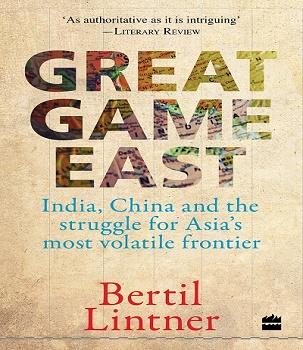Arthur Conolly, an intelligence officer of British East India Company, conceived the expression “great game” to define the strategic rivalry between the British and the Russian empires to acquire supremacy in Central Asia. It was further used to define rivalries between the United States and other Western powers vis-a-vis Russia and China over usage of Central Asia’s resources. Bertil Linter, in his book, contextualised the expression ‘Great Game’ for Asia, existing at the crossroads of the Indian Subcontinent, China and Southeast Asia. The overall theme of the book is to examine Sino-Indian rivalries in Tibet, North-East India, Myanmar and the Indian Ocean region. The author’s extensive research in Tibet and the Himalayas and personal experiences of travelling in North-East India, Myanmar and China as a journalist has helped in documenting minute details and accounts of the local narratives of people, non-state actors, spies and agents, journalists and authors and most importantly, government officials and authorities.
The first chapter gives a detailed chronology of events depicting India-China rivalry since the 1950s that eventually led to the war of 1962. The cordial relations defined under the banner of ‘Hindi Chini Bhai Bhai”, turned sour with Chinese claims over Tibet. Furthermore, Tibet’s spiritual leader set up a government in exile in the foothills of the Indian Himalayas. The unresolved issue of the McMahon Line, the border established by the British imperial government, but not accepted by Beijing led to hostilities between the two countries. The war of 1962 made a permanent dent to the cordial bilateral relations between the two countries, whose repercussions can still be felt with unsettled borders and frequent intrusions. To authenticate his findings, he gives accounts of CIA agents, Western Experts and Tibet sympathisers and retired service members.
In the next three chapters, the author catalogues the various revolutionary movements occurring inthe North-Eastern States of India, i.e. Nagaland, Mizoram and Manipur. He underlines the British policies towards the Hills and the role of missionaries during the British rule. The territorial claims and insurgent disputes in the region continued during British rule. Post-independence, the author describes the sequence of events that intensified these insurgent movements, claiming separate status or separate nation for themselves. The intricacies of the insurgent movements and the way the Indian Government responded are explained with great simplicity for the reader’s understanding. The author has specified reasons for India’s success in North-East India, in which India worked with diplomacy and successfully suppressed a few of the insurgent movements, if not all. The author puts forth the Kautilya’s ‘Arthashastra’ as a political doctrine which has guided the Indian RAW and other intelligence agencies to learn the art of conducting espionage, covert operations and surveillance. Another factor which the author has highlighted and is aptly true is that no single ethnic tribe that dominates the North-East region. For instance, Nagas claim parts of Manipur and Myanmar as part of the greater “Nagalim”, but in terms of population numbers, Nagas account for only 10 to 20% of the population in the region.
The author gives a detailed account of the outside support these movements received from Pakistan (East Pakistan, now Bangladesh), which provided safe sanctuaries to the ethnic insurgents in North-East India. And, simultaneously by China post the 1962 war, which ensured no peace could be attained between India and China. The arrival of Thinoselie Muivah and their contingent of Naga rebels on the Yunan frontier in 1967 marked the beginning of China’s involvement in ethnic rebel movement in North-East India. The book reflects on the continuous support that China has given for an anti-India cause through training in ideology formulation and supply of weapons, and use of their southern provinces of Yunnan, Guangxi. Though the author specifies that the Chinese did not initiate the North-East insurgency, nevertheless they took advantage of the exiting issues in the region and provided them military training and weapons to challenge the idea of India as a nation.
In the chapters on Mizoram and Manipur, we find mention of foreign interference by providing sanctuaries and training and weapons to rage uprisings in India. The Mizoram story revolves around the crises that intensified post the Famine in 1958 “mautam” called as bamboo death, caused due to rats to the evolution of the Mizo National Front (MFN) claiming its sovereignty with the help of an armed struggle. The leader, Laldenga, reached East Pakistan in 1963, to claim support from Pakistan. Till 1966, Mizos and other leaders of MFN, crossed the border to acquire training and weapons and finally launched ‘Operation Jericho’ in 1966. Soon China started meddling with the internal affairs of Mizoram, by supplying money, equipment, and military training to continue their fight. The author gives an extensive account of the rise of the movement in the Mizo hills, and the setbacks it faced in the process, especially after the declaration of Bangladesh Independence and the death of Mao Zedong in China. While explaining the Manipur story, the author gives the social and economic context of the State, and how the Independent Peasant Republic and its armed organisation Red Guards grew in strength. Again the support was earlier derived from East Pakistan and later by China and Burma’s Kachin and Wa rebels. He mentions the rise of Sana Yaima in Manipur and why the state was declared a “disturbed area” in 1980. He also looks into the complex rivalry between Kukis and Nagas.
To understand the North-East complexities better, the author establishes a close relationship that States had with the neighbouring Burma State in a separate chapter. The Burma State was also facing the trouble of ethnic insurgent groups. The problems multiplied due to the presence of drug lords and increasing money laundering in both Burma and North-East India, which disturbed the regions politically as well as economically. He narrates the story of Burma’s Independence from British rule and its political journey. The author focusses on the rise of the military rule in 1962 and the emergence of ethnic armed groups in Kachin, Wa, Shan and Karen regions. In chapter five, while discussing the Bangladesh historical context, the author reflects on the times when Bangladesh Nationalist Party was in power, providing sanctuaries to Indian insurgent group, United Liberation Front of Assam (ULFA) to continue their operations. The continued support for the transportation of weapons through their territory and the development of close cooperation with Assam insurgent groups are explained.
In the seventh chapter, the author highlights the struggle for strategic access to the Indian Ocean, explaining the shift in the Great Game from Tibet, Himalayas and North East India to the Indian Ocean and the two islands, i.e. the Andamans and the Coco Islands. The chapter elaborates on transportation of weapons through the Bay of Bengal either for the North East insurgents and further to Burmese insurgents or for the Tamil insurgents. His detailed investigation in these cases has helped evolve a clear picture of the activities taking place in the Andaman Islands and the Coco Islands. Here too, the conflict, whether it is Chinese presence or is it India’s interests being served, is discussed. Concerns are raised with China developing a military base in Great Coco, the main island of Burmese territory.
Here, the author examines China’s economic and strategic interests in the South Asia and South-East Asia, for example, the String of Pearls project, which aimed to reach out from the Middle East to Pakistan, Sri Lanka, Bangladesh and Burma. The author also discusses the rich forest and mineral resources and natural gas and hydroelectric power potential of Burma that has attracted China’s interest since the 1980s. From an earlier policy of supporting the Communist policy of Burma and ethnic insurgent groups, China slowly shifted its political agenda to create economic dependency through trade and commerce. The description of Wa state and presence of the Chinese currency in the region describes the economic expansion of China in Burma. However, within a decade, China’s strategic interest got revealed with exporting of military equipment to Burma and sharing of Burma’s intelligence for oil shipments and other movements in the Indian Ocean. The book explores the dubious side of China’s policies towards Burma and how are they responding to the same. For example, in 2009 the Burmese troops pushed out thirty thousand of Chinese nationals and local people back to China and later the suspension of the Myitsone dam in 2011.
While narrating India’s stand, the author argues that India initially supported the pro-democracy movements in Burma in the 1980s, by helping Aung San Suu Kyi’s efforts. However, in the 1990s, India moved to establish close relations with the existing seat of power, ie. the military generals and started to expand India’s strategic and economic interests. From increasing trade to exploring new markets in the South East region, India started connectivity projects with Burma. On the strategic front, India started providing non-lethal military support to Burmese troops, like combat gears and troop’s uniforms. According to the author, India’s interests are underscored by the need to control the ethnic armed insurgents who sometimes take refugee in Burma’s territory, as mentioned in previous chapters of the book. India has also adopted its 'Cultural Diplomacy' as a tool in Myanmar to serve India's interests for peace and prosperity in the NorthEast. For example, around the mid 1990s All India Radio (AIR) stopped broadcasting anti-junta rhetoric. The appendixes on the chronology of events and description of armed non-state actors in North-East India, the Chittagong Hill Tracts and Northern Burma gives readers a very good understanding of the subject at hand.
The game, clearly, is not yet over according to Bertin Linter. As populalry claimed, the 21stcentury is the Asian century; and this book attempts to shed light on the geostrategic region of the world and rise of the two Asian Giants. The book is an excellent read, especially if one aims to understand the historical context of rivalry between India and China, who continues to challenge the presence of each other in the Asian region.











Post new comment